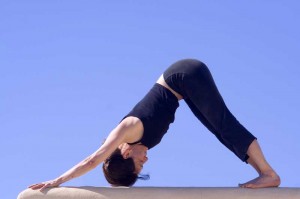The best offense against muscle pain is a good defense. Dr.
The best offense against muscle pain is a good defense. Dr. Edward Soriano, D.O., Department of Physical Medicine and Rehab at Sinai Hospital, advises that a few simple stretches can keep the spring in your step, whether you’re an experienced athlete or consider gripping the armrest of your recliner and hollering at the refs to be your weekly cardio.
The next time you’re relaxing in bed, try curling your knees to your chest, one at a time, and slowly releasing them. If you’re gearing up to hit the treadmill or just killing time during commercials, you should also try a few basic runners’ stretches. Wall push-ups are especially easy: Stand roughly three feet from a wall with your feet at shoulder width. Keeping your arms straight, flatten your hands against the wall. Then lean your hips forward, bending your knees slightly to stretch your calves.
For an even deeper stretch, bend forward to lower your body to waist height and bring one foot forward (keeping your knee still slightly bent); then lift the toes of the front foot to stretch the muscle under the calf. Your body will be humming along happily afterward.
Ground control to Major Tom: Take your calcium and put your helmet on. Space may be the final frontier, but it sure doesn’t do a body good. Our planet’s gravitational field applies a constant pressure on our skeletal systems, which forces healthy bones to maintain the density needed to support our bodies. So astronauts floating through a zero-gravity environment often experience bone loss, and when they return to earth, they’re more susceptible to fractures.
Astronauts often use restraints to strap themselves to a treadmill just to create the necessary weight-bearing environment. Here on earth, things are a little simpler: Walking the dog, jamming out with our iPods while jogging, or joining a pick-up game of basketball are good ways to make sure we build bone mass
Snap, crackle, pop: Some of us hear this familiar little ditty whenever we get up from our desks and indulge in a good long stretch. These aren’t the sounds of three elves doing a conga-line around a bowl of milk; they’re simply our joints in motion. A healthy joint is comprised of bone that is supported by smooth cartilage, which is, in turn, protected by a capsule lined with fluid-producing synovial membranes. This fluid is made up of oxygen, nitrogen, and carbon dioxide gases; when joints crack, these capsules stretch, which produces and releases gas bubbles.
“The sound is kind of like opening a bottle of soda,” Dr. Soriano muses. “Because it’s opening the joint, which creates a negative pressure and lets nitrous gas escape, and that creates the pop.”
Though old wives’ tales and internet comments alike caution us that cracking our knuckles will lead to arthritis, Dr. Soriano says that it’s okay to feel your joints occasionally crack during normal stretching. However, if you find yourself cracking your spine excessively, you’re not only grossing out your officemates, you should probably consult a physician to find out what is causing the pain and pressure.
-Laura Bogart